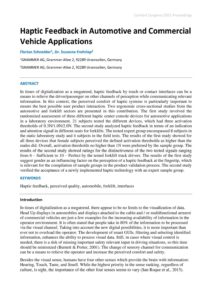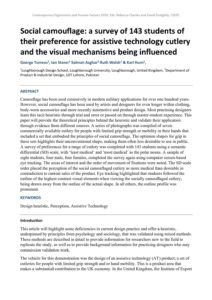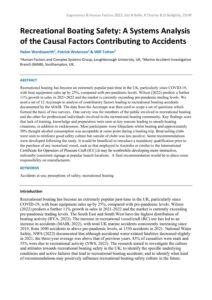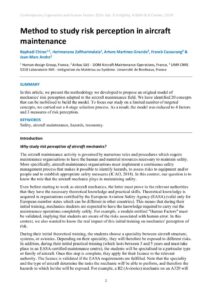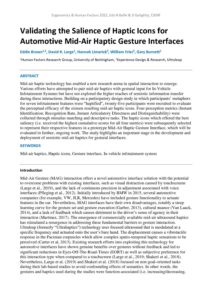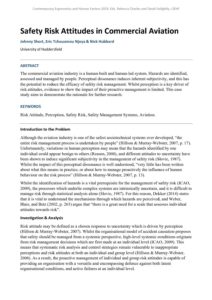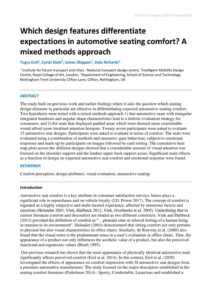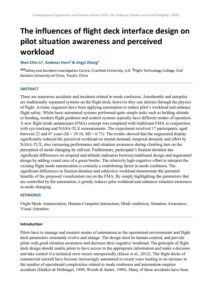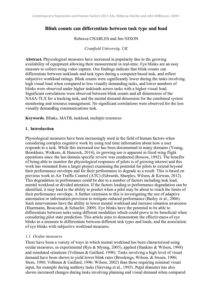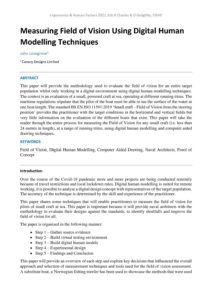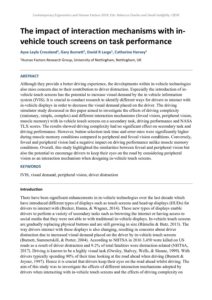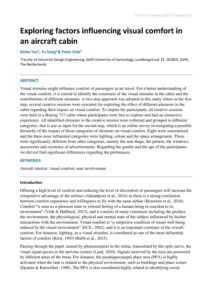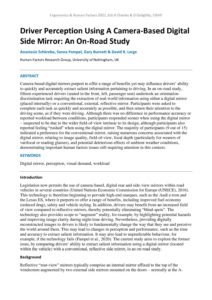Perception
Haptic Feedback in Automotive and Commercial Vehicle Applications
Social camouflage: a survey of 143 students of their preference for assistive technology cutlery and the visual mechanisms being influenced
| Document | Author George Torrens, Ian Storer, Salman Asghar, Ruth Welsh & Karl Hurn |
| Abstract Camouflage has been used extensively in modern military applications for over one hundred years. However, social camouflage has been used by artists and designers for even longer within clothing, body-worn accessories and more recently automotive and product design. Most practising designers learn this tacit heuristic through trial and error or passed on through master-student experience. This paper will provide the theoretical principles behind the heuristic and validate their application through evidence from different sources. A series of photographs was compiled of seven commercially available cutlery for people with limited grip strength or mobility in their hands that included a set that embodied the principles of social camouflage. The optimum shapes for grip in these sets highlights their unconventional shape, making them often less desirable to use in public. A survey of preferences for a range of cutlery was completed with 143 students using a semantic differential (SD) scale, with ‘least medical’ and ‘most medical’ as the polar nouns. A sample of eight students, four male, four females, completed the survey again using computer screen-based eye tracking. The areas of interest and the order of movement of fixations were noted. The SD scale order placed the perception of the social camouflaged cutlery as more medical than desirable in contradiction to current sales of the product. Eye tracking highlighted that students followed the outline of the highest contrast visual elements when viewing the socially camouflaged cutlery; being drawn away from the outline of the actual shape. In all others, the outline profile was prominent. |
Recreational Boating Safety: A Systems Analysis of the Causal Factors Contributing to Accidents
| Document | Author Helen Wordsworth, Patrick Waterson & Will Tutton |
| Abstract Recreational boating has become an extremely popular past-time in the UK, particularly since COVID-19, with boat equipment sales up by 25%, compared with pre-pandemic levels. Wilson (2022) predicts a further 11% growth in sales in 2021-2022 and the market is currently exceeding pre-pandemic trading levels. We used a set of 12 Accimaps to analyse of contributory factors leading to recreational boating accidents documented by the MAIB. The data from the Accimaps was then used to scope a set of questions which formed the basis of two surveys. One survey was for members of the public involved in recreational boating and the other for professional individuals involved in the recreational boating community. Key findings were that lack of training, knowledge and preparation were seen as key reasons leading to unsafe boating situations, in addition to recklessness. Most participants wore lifejackets whilst boating and approximately 50% thought alcohol consumption was acceptable at some point during a boating trip. Boat/sailing clubs were seen to reinforce good safety culture but outside of clubs was less positive. Some recommendations were developed following the study. It would be beneficial to introduce a mandatory qualification prior to the purchase of any motorised vessel, such as that employed in Australia or similar to the International Certificate for Operators of Pleasure Craft (ICC).It may be worthwhile developing more interactive, nationally consistent signage at popular launch locations. A final recommendation would be to place some responsibility on manufacturers. |
Method to study risk perception in aircraft maintenance
| Document | Author Raphaël Chirac, Herimanana Zafiharimalala, Arturo Martinez-Gracida, Franck Cazaurang & Jean-Marc Andre |
| Abstract In this article, we present the methodology we developed to propose an original model of mechanics' risk perception adapted to the aircraft maintenance field. We have identified 20 concepts that can be mobilised to build the model. To focus our study on a limited number of targeted concepts, we carried out a 4-stage selection process. As a result, the model was reduced to 4 factors and 3 measures of risk perception. |
Validating the Salience of Haptic Icons for Automotive Mid-Air Haptic Gesture Interfaces
| Document | Author Eddie Brown, David R. Large, Hannah Limerick, William Frier & Gary Burnett |
| Abstract Mid-air haptic technology has enabled a new research arena in spatial interaction to emerge. Various efforts have attempted to pair mid-air haptics with gestural input for In-Vehicle Infotainment Systems but have not explored the higher reaches of semiotic information transfer during these interactions. Building on a participatory design study in which participants’ metaphors for seven infotainment features were “haptified”, twenty-five participants were recruited to evaluate the perceptual efficacy of the sixteen resulting mid-air haptic icons. Four perception metrics (Instant Identification, Recognition Rate, Instant Articulatory Directness and Distinguishability) were collected through stimulus matching and descriptive tasks. The haptic icons which offered the best saliency (i.e. received the highest cumulative scores for all four metrics) were subsequently selected to represent their respective features in a prototype Mid-Air Haptic Gesture Interface, which will be evaluated in further, ongoing work. The study highlights an important stage in the development and deployment of semiotic mid-air haptics for gestural interfaces. |
Safety Risk Attitudes in Commercial Aviation
| Document | Author Johnny Short, Eric Tchouamou Njoya & Nick Hubbard |
| Abstract The commercial aviation industry is a human-built and human-led system. Hazards are identified, assessed and managed by people. Perceptual dissonance induces inherent subjectivity, and this has the potential to reduce the efficacy of safety risk management. Whilst perception is a key driver of risk attitudes, evidence to show the impact of their proactive management is limited. This case study aims to demonstrate the rationale for further research. |
Clothing comfort – Consumer expectation and perception of sports garments
Which design features differentiate expectations in automotive seating comfort? A mixed methods approach
The influences of flight deck interface design on pilot situation awareness and perceived workload
| Document | Author Wen-Chin Li, Andreas Horn & Jingyi Zhang |
| Abstract There are numerous accidents and incidents related to mode confusion. Autothrottle and autopilot are traditionally separated systems on the flight deck, however they can interact through the physics of flight. Avionic engineers have been applying automation to reduce pilot’s workload and enhance flight safety. While basic automated systems performed quite simple tasks such as holding altitude or heading, modern flight guidance and control systems typically have different modes of operation. A new flight mode annunciator (FMA) concept was compared with traditional FMA in conjunction with eye-tracking and NASA-TLX measurements. The experiment involved 17 participants, aged between 22 and 47 years (M = 29.18, SD = 6.73). The results showed that the augmented display significantly reduced the perceived workload on mental demand, temporal demand, and effort by NASA-TLX; also increasing performance and situation awareness during climbing turn on the perception of mode changing by call-out. Furthermore, participant’s fixation duration has significant differences on airspeed and altitude indicators between traditional design and augmented design by adding visual cues of a green border. The relatively high cognitive effort to interpret the existing flight mode annunciation is certainly a contributing factor in mode confusion. The significant differences in fixation duration and subjective workload demonstrate the potential benefits of the proposed visualization cue on the FMA. By simply highlighting the parameters that are controlled by the automation, it greatly reduces pilot workload and enhances situation awareness in mode changing. |
Blink counts can differentiate between task type and load
| Document | Author Rebecca CHARLES and Jim NIXON |
| Abstract Physiological measures have increased in popularity due to the growing availability of equipment allowing their measurement in real-time. Eye blinks are an easy measure to collect using video capture. Our findings indicate that blink counts can differentiate between taskloads and task types during a computer-based task, and reflect subjective workload ratings. Blink counts were significantly lower during the tasks involving high visual load when compared to less visually demanding tasks, and lower numbers of blinks were observed under higher taskloads across tasks with a higher visual load. Significant correlations were observed between blink counts and all dimensions of the NASA-TLX for a tracking task, and the mental demand dimension for the combined system monitoring and resource management. No significant correlations were observed for the less visually demanding communications task. |
Measuring Field of Vision Using Digital Human Modelling Techniques
| Document | Author John Lovegrove |
| Abstract This paper will provide the methodology used to evaluate the field of vision for an entire target population whilst only working in a digital environment using digital human modelling techniques. The context is an evaluation of a small, powered craft at sea, operating at different running trims. The maritime regulations stipulate that the pilot of the boat must be able to see the surface of the water at one boat length. The standard BS EN ISO 11591:2019 ‘Small craft – Field of Vision from the steering position’ provides the practitioner with the target conditions in the horizontal and vertical fields but very little information on the evaluation of the different boats that exist. This paper will take the reader through the entire process for measuring the Field of Vision for any small craft (i.e. less than 24 metres in length), at a range of running trims, using digital human modelling and computer aided drawing techniques. |
The impact of interaction mechanisms with in-vehicle touch screens on task performance
| Document | Author Ayse Leyla Crossland, Gary Burnett, David R Large, Catherine Harvey |
| Abstract Although they provide a better driving experience, the developments within in-vehicle technologies also raise concern due to their contribution to driver distraction. Especially the introduction of in-vehicle touch screens has the potential to increase visual demand by the in vehicle information system (IVIS). It is crucial to conduct research to identify different ways for drivers to interact with in-vehicle displays in order to decrease the visual demand placed on the driver. The driving simulator study discussed in this paper aimed to investigate the effects of driving complexity (stationary, simple, complex) and different interaction mechanisms (foveal vision, peripheral vision, muscle memory) with in-vehicle touch screens on a secondary task, driving performance and NASA TLX scores. The results showed driving complexity had no significant effect on secondary task and driving performance. However, button selection task time and error rates were significantly higher during muscle memory conditions compared to peripheral and foveal vision conditions. Conversely, foveal and peripheral vision had a negative impact on driving performance unlike muscle memory conditions. Overall, this study highlighted the similarities between foveal and peripheral vision but also the potential to encourage drivers to keep their eyes on the road by considering peripheral vision as an interaction mechanism when designing in-vehicle touch screens. |
Exploring factors influencing visual comfort in an aircraft cabin
Driver Perception Using A Camera-Based Digital Side Mirror: An On-Road Study
| Document | Author Anastasia Schkreba, Sanna Pampel, Gary Burnett & David R. Large |
| Abstract Camera-based digital mirrors purport to offer a range of benefits yet may influence drivers’ ability to quickly and accurately extract salient information pertaining to driving. In an on-road study, fifteen experienced drivers (seated in the front, left, passenger seat) undertook an orientation-discrimination task requiring the extraction of real-world information using either a digital mirror (placed internally) or a conventional, external, reflective mirror. Participants were asked to complete each task as quickly and accurately as possible, and then return their attention to the driving scene, as if they were driving. Although there was no difference in performance accuracy or reported workload between conditions, participants responded sooner when using the digital mirror – suspected to be due to the wider field-of-view intrinsic to its design, although participants also reported feeling “rushed” when using the digital mirror. The majority of participants (9 out of 15) indicated a preference for the conventional mirror, raising numerous concerns associated with the digital mirror, relating to image quality, field-of-view, focal depth (particularly for wearers of varifocal or reading glasses), and potential deleterious effects of ambient weather conditions, demonstrating important human factors issues still requiring attention in this context. |

